Harry Lambert on Putting Harry Styles in Pearls and His First Clothing Collection

- Oops!Something went wrong.Please try again later.
This is an edition of the newsletter Show Notes, in which Samuel Hine reports from the front row of the spring and fall fashion weeks. Sign up here to get it in your inbox.
As one of the most prominent and influential figures in his field, the fashion stylist Harry Lambert, 36, has the kind of close relationship with elite designers and luxury brands that other stylists (and their celebrity clients) would kill for. He can command an entire boutique’s worth of custom looks from Gucci when his longtime client Harry Styles goes on tour, and collaborates with heavyweights like Miuccia Prada and Jonathan Anderson to turn Emma Corrin’s red carpet appearances into true pop culture moments.
Ironically, Lambert has had a harder time tracking down the kinds of clothes he likes. “There are all these things that I always wanted to wear that I've never been able to find,” he tells me over Zoom from his plant-filled studio in east London. So when he got the chance, he decided to make them. Lambert’s very own collection of clothes, which he designed for Zara, hits stores on November 13. “It felt like an opportunity that would be silly to not take. Initially it was a very selfish point of view. I was like, Oh my God, I can make my dream wardrobe. How exciting is this?”
Most of the work of fashion stylists, even those familiar to the triple-A-list, once happened behind the scenes. The job was more garment steamers and hotel room service than movie premiers and black tie galas. But as I reported earlier this year, the role—while becoming more challenging—is more influential than ever. Now, many celebrity stylists are celebs themselves.
Lambert is a prime example. If stylists once served mostly as gatekeepers of taste between famous people and luxury brands, Lambert thinks of his role as closer to that of a creative director. His collaboration with Styles, for one, deliberately elevated a radical shift in masculine norms in menswear, guided by the taste of a true fashion devotee. Styles is best known for his relationship with Alessandro Michele’s Gucci, but Lambert also introduced him (and therefore millions of other people) to smaller brands he believed in, like Bode and S.S. Daley. Online, fashion maniacs quickly picked up on Lambert’s impact, and he became a muse of his own to an obsessive fanbase.
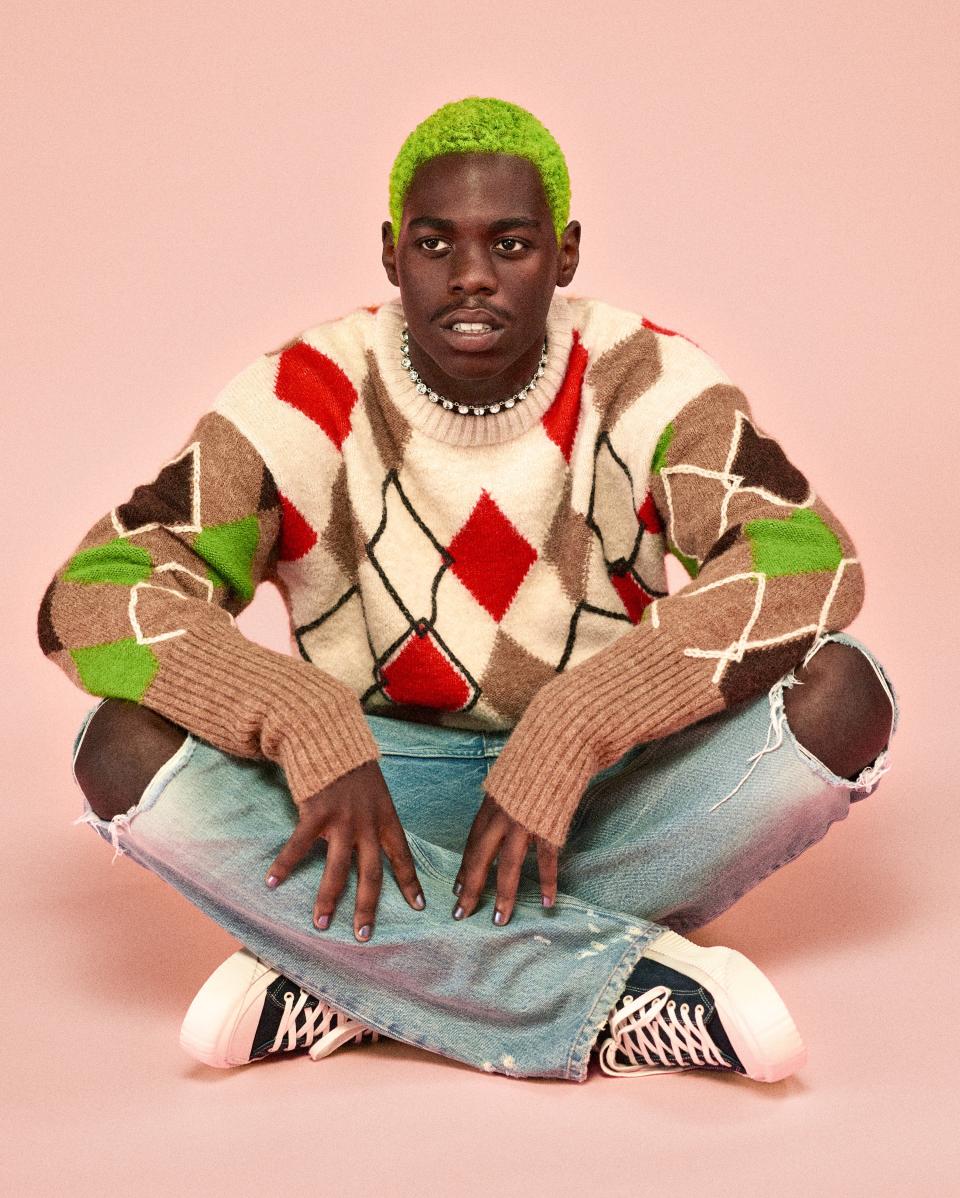
Zara is betting that Lambert’s following will jump at the opportunity to, in a sense, be styled by him. (It’s worth noting that Gen Z is both in thrall of “fast fashion” and cares about sustainability and where their clothes come from; Lambert’s collection uses 100% “lower impact fibers,” according to Zara.) The 60+ piece collection, dubbed “Cutie Chaos,” is a mood-boardy mix of the twisted, fun classicism that defines Lambert’s eye. There’s a selection of vintage items he finds hard to come by these days, like mechanic jackets, brown suits, and sweater vests; the heritage fabrics clash with campy colors and plush textures. Lambert is a knitwear specialist, and his sweaters, cropped and, yes, cute, are particularly strong. There are also plenty of pieces that look exactly like what Lambert wears in his day-to-day life, namely candy-stripe dress shirts, funky graphic tees, and crystal necklaces.
Lambert and I talked about his changing position and much more, including his relationship with trends and how he put Harry Styles in pearls.
GQ: It’s funny how closely this collection is aligned with your personal style. I think that says a lot about where we are in fashion right now. Fifteen years ago, nobody knew much about fashion stylists, and certainly not how they dressed. Now you can release a collection of clothing inspired not by what your clients wear, but by what you wear. It’s very modern.
Harry Lambert: I think that was what was fun about it. I wanted this collection to not be super trend focused, but super fun at the same time, and super well-made. I think that was really important. I don't really love trends, and I know trends are such an important part of our industry. Maybe this does fit into certain trends, but when designing it, it wasn't about making it trend-focused. It was like: this coat you should be able to wear forever.
But it's interesting, I'm a really big fan of pop culture and pop culture moments, but I love the idea of being behind the scenes. I never came into this job being like, I want to be front and center. I really enjoy getting people ready and then sending them on the way and seeing the reaction. So it's interesting that in the last several years we've become more of a focus. It's a lot of adjusting to that, and getting out of my comfort zone, which is getting easier. But I dunno, I feel the job of a stylist is so broad now that it’s literally the dream job.
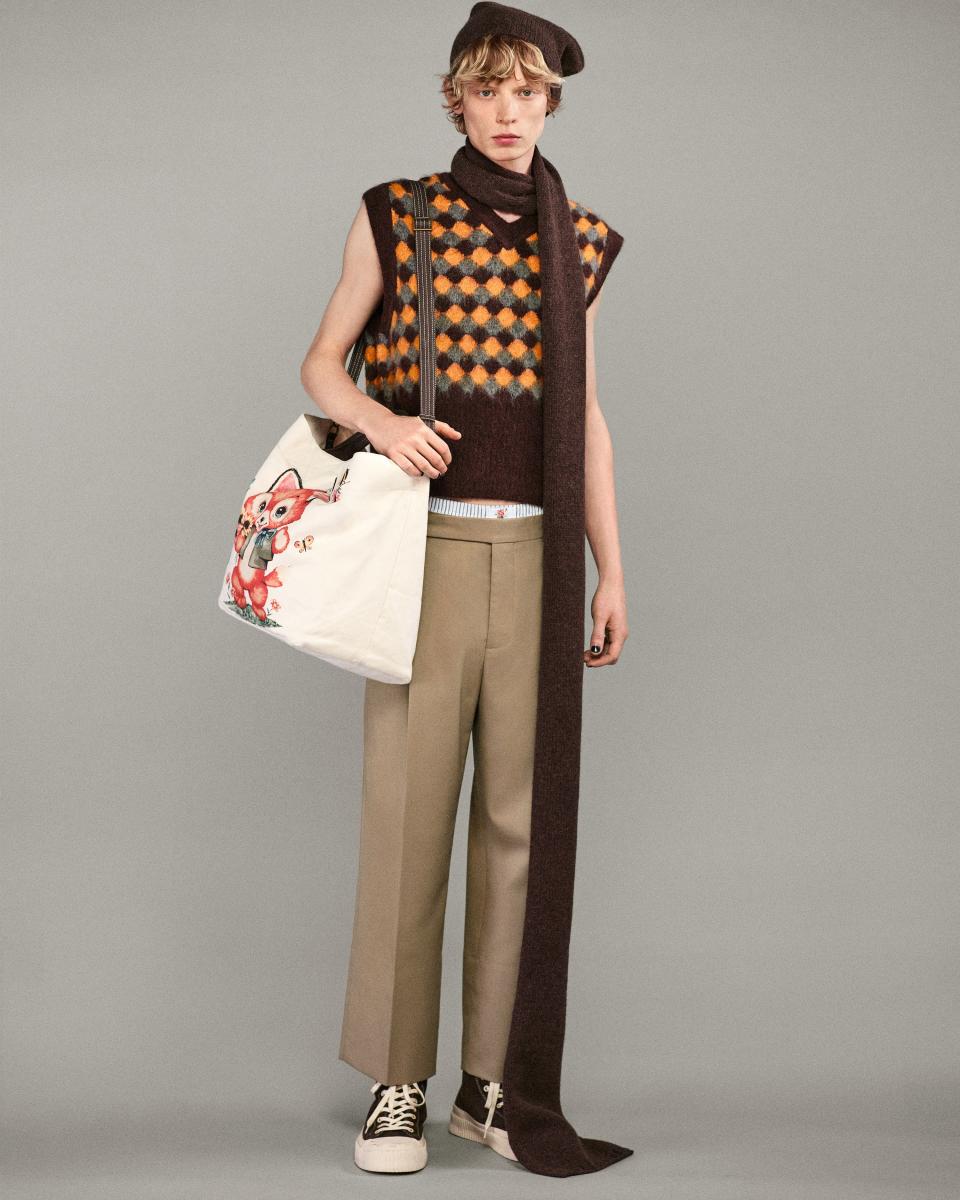
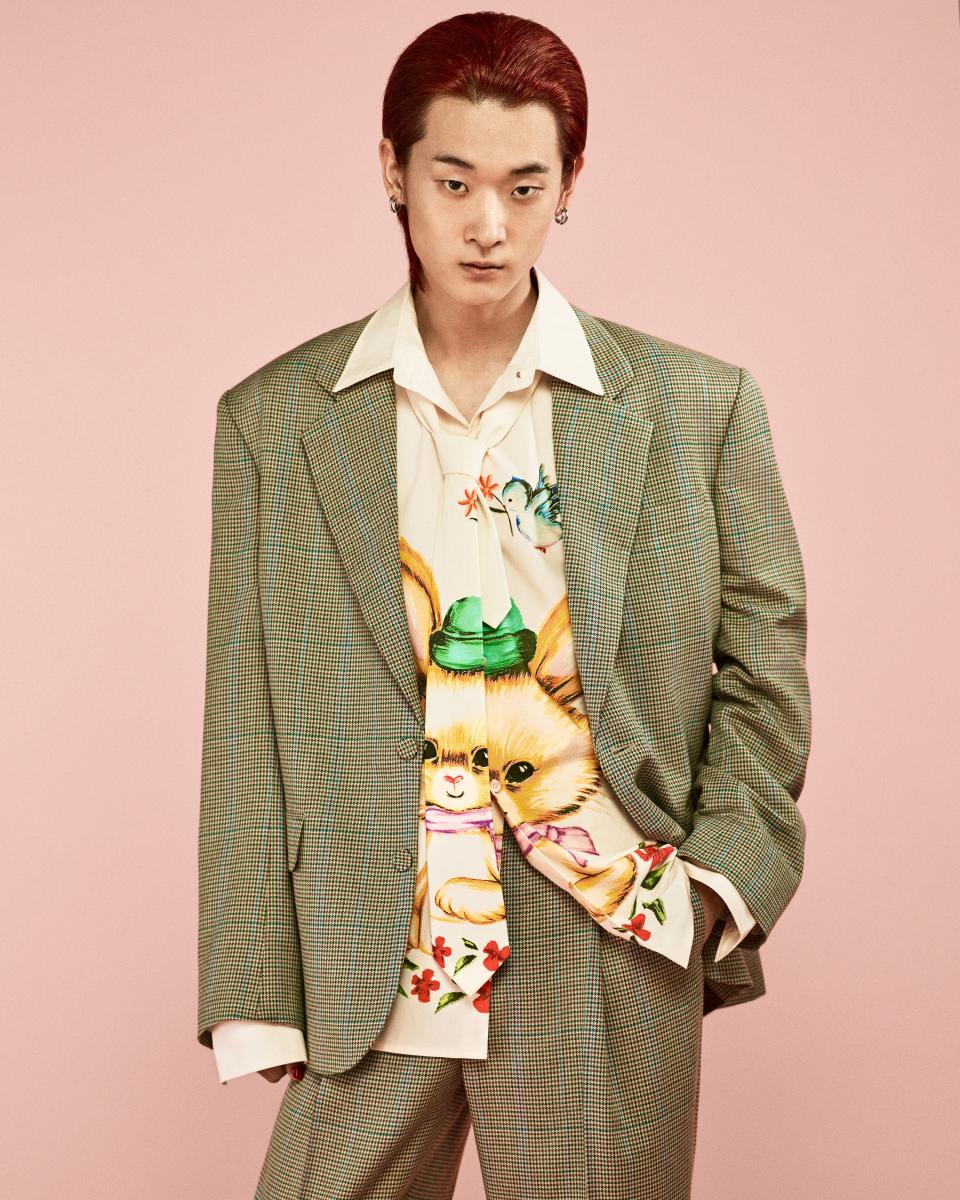
Tell me more about your relationship with trends. I think some people would assume that stylists are kind of responsible for building trends. When you work with your clients, it seems to me like you’re trying to do something totally different.
It's a funny thing. With Emma Corrin for example, we put them in the green Miu Miu underwear set, and I guess that's a trend. But the intention wasn't because it was on trend. It was more like: that will be sick and amazing. It's a weird thing to say, but I always want to try and be ahead, I don't want to follow what other people have done. But then you are taking looks from the runway, and you're executing those trends, or starting them, I guess.
But when it comes to working on an album cycle with Harry [Styles] or something like that, we plan out custom outfits and an overarching theme. And maybe the themes don't fit into the runway trends, but then we work with brands to create those looks and then they become trends. I don't know. It is interesting. I always wonder when the stylist thing started to become more front facing. Maybe Rachel Zoe was probably one of the first, and I think Law Roach as well, those stylists are the ones that brought us more towards the front.
But it was American thing. We always talk about it here [in London], back in the day, Katy England and Alister Mackie and Bryan McMahon and Katie Grand used to do all the music videos. I think Katie Grand did a Spice Girls one. Alister Mackie did a Robbie Williams one, and everyone's wearing archive McQueen in one of the videos. Here we had those stylists doing that, but talent dressing was a bit of a dirty word, and you did it in the background to make money. Whereas I think in America it was much more of a positive thing. And now all stylists want to work with talent.
A number of stylists I’ve talked to say that the talent side has gotten really challenging recently because there are so many people to dress, so many events, and so few looks. There’s also so much more scrutiny on their work, and things like brand deals at play. What’s your perspective on that?
Yeah, it's hard. There are a lot of TV shows now, and there's a lot of music. So there are a lot of people that want dressing. And I'm really lucky that I have lots of people approach me to dress them. But I have this mentality that if I can't give you enough of my time, I don't want to do it. I need to be fully in, and I really need to be in on the project, really relate to that person, and feel like we can work together as a team. And it is hard. I went through a phase when I was reading too many comments about my work. It was so out there and it really, at one point it affected me, and Twitter was all dramatic, and I was just like, I'm not looking at this anymore. And now I'm fine with it, but there's a lot of scrutiny. But I think if people aren't debating what you're doing, then you're not doing something right anyway. If someone over here doesn't like what Emma Corrin’s wearing, good, they've noticed.
Right, and not every moment or look has to be for everybody.
Exactly. I always think that a lot of the best fashion moments in history have been outfits that people don't understand or get.
What looks come to mind in particular?
The Björk swan dress. Celine Dion wearing the [John Galliano] jacket back to front. Or even the guys from South Park wearing ball gowns on the Oscars red carpet, or Alexander Skarsgård wearing just underwear. I prefer when people are debating. When Emma Corrin wore the JW Anderson fish dress, for me, seeing the comments made me so happy, because it was pleasant that so many people actually did get it. We're never doing it to shock, but I think audiences of red carpets are actually way more hungry for fun rather than just loads of boring dresses and suits. Everyone's still horribly critical, but I think they’re a little less critical these days if someone's taking a risk. I think people get criticized now if they just turn up in a black suit. Guys can't get away with black suits anymore.
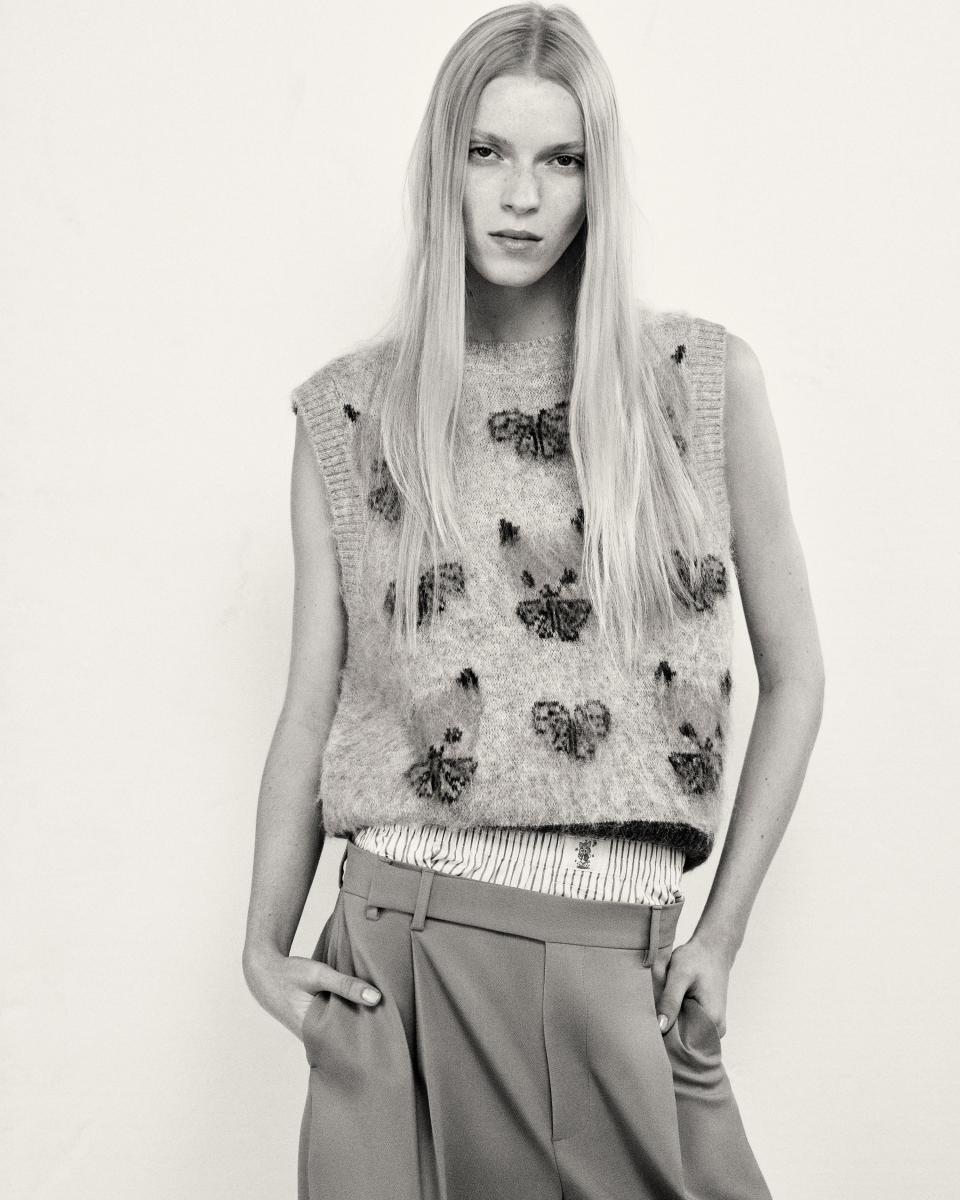

One thing that strikes me about your work is that everything your clients wear, even if it’s straight off the runway, looks like it's been pulled right out of their closet. How do you achieve that?
Well for example, me and Emma were friends first before work partners. But look, Emma has really great personal style, so I have to give credit to that. And I think we’ve always gone on a journey together in working out what they want to wear or how they want to wear things. And it's about complete transparency and dialogue.
The amount of times I'll meet a talent and find out that they've not been happy with what they've been wearing on the red carpet, that always shocks me. Whenever I start working with someone, I'm like, If you don't like something, you need to tell me. Because there's nothing worse than going back and being like, God, you looked great! And they say, Actually, I felt awful and I didn't like it. What's the point? That's stupid. So I think with Emma and everyone I work with, it’s about transparency and it's about honesty and not about offending each other. I'm not going to get offended if you don't want to wear something. I'm being paid to make you feel the best and look the best that you can. And if you're not feeling like that, then I haven’t done my job.
What does it take for you to say yes to a new client, besides being able to devote the time to them that they deserve. What do you look for exactly?
I either like a clean slate, like someone new who hasn’t done anything big. Someone you almost start from scratch with. But then for me, Eddie [Redmayne] was already a stylish person. I always remember him being quite ahead of his time and taking risks and stuff. He was someone that I think is really talented and wanted to wear clothes. I don't think I've reinvented anyone, but I don't know. I need to be excited. Next year I've got a couple of new clients, potentially a female pop star, hopefully. I haven't done a female pop star. I feel like they kind of have a clean slate. We could really do something epic. I'm a geek for pop culture and Madonna and Britney and all that, and I get to play a bit of that fantasy through Harry and Emma. So I think I'm going to have fun with that person.
Is it Taylor Swift?
[Laughs] It’s not Taylor Swift.
Last week I wrote about Travis Kelce and how a lot of guys, whether they are regular people or celebrities, dress in full looks now. Their outfits are super cohesive, whether they work with professional stylists or not. I’m curious about your take on this.
I think we've hit that generation now where fashion is cool for the normal guy. I remember being bullied for being interested when I dressed when I grew up. Now it's like everywhere, everyone, you know what I mean? Recently a friend was like, Everybody wants to be us. We're just in that world now where guys know what Jil Sander is. And even if it is a very surface level and they don't know the history or whatever, it doesn't matter. I don't think it matters. Isn't that what our job is, is to bring those clothes and those looks to everyone?
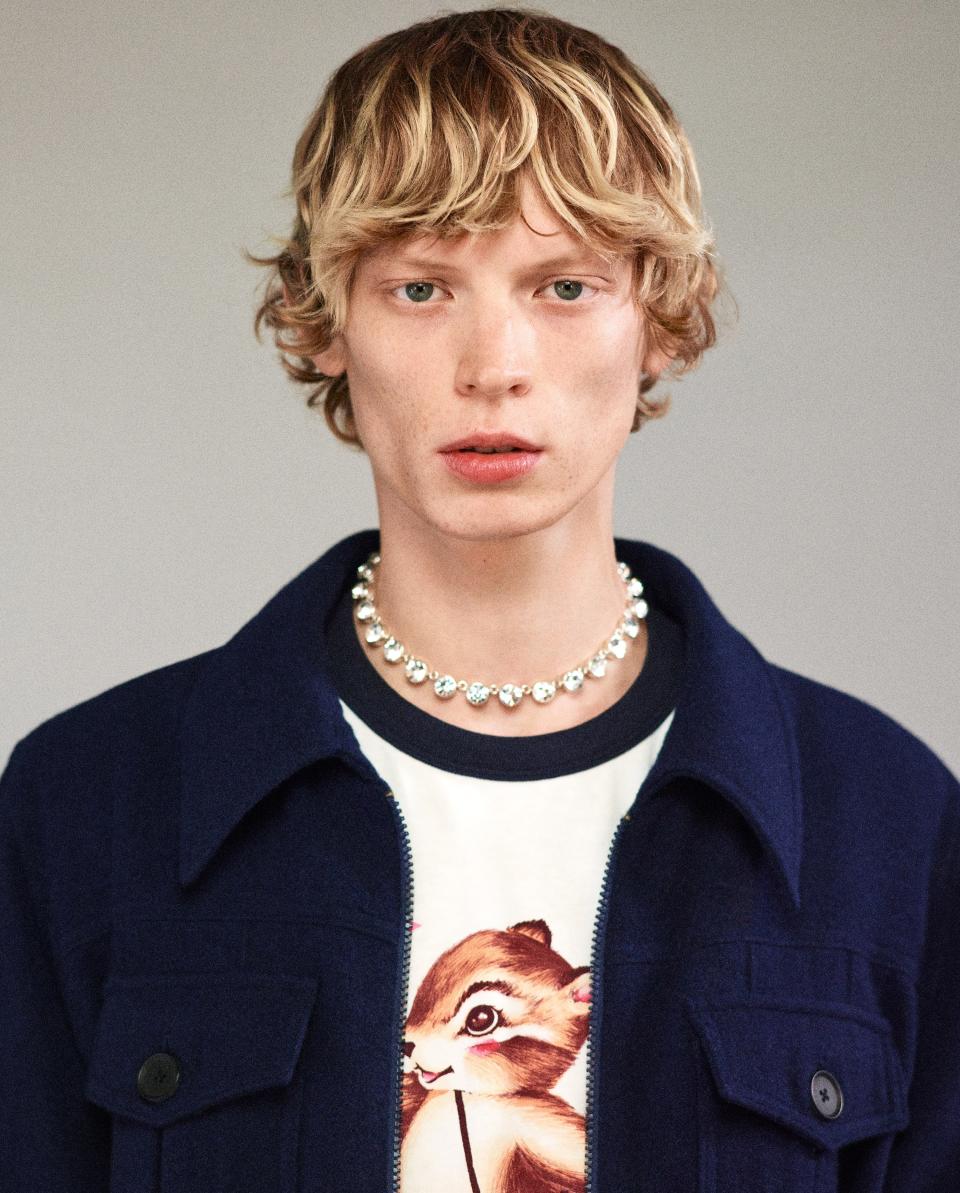
Your Zara collection has traditionally masculine silhouettes, but also these cute details and a softness to it that feels more feminine. It makes me think of how hard masculinity in menswear has shifted in the past ten years or so. Obviously there are a ton of different reasons for that, but one super visible thing that happened during that time was your work with Harry Styles, which elevated a more fluid masculine presentation. Do you see your collaboration as influential, and how do you think about your role in how these norms have changed?
It’s funny looking back, but I guess it has been nearly 10 years working together. I think the pearls are a very easy one to see. And I always say we were not the only ones doing pearls. A$AP Rocky and Pharrell were wearing them, and there had just been a Comme des Garçons [Homme Plus] show with pearls. And I think the ones we used were some vintage ones I found in a vintage rental place. And now, I dunno if boys still wear them, but there was an era where every boy was wearing pearls and stuff. And so there's those little things that you see trickle down. I really noticed the JW Anderson cardigan thing during lockdown, and the sweater now being on exhibition in the [Victoria and Albert Museum in London], that is special to me. I see it, you know what I mean? It's fun to be part of that. But I think I never go into the intention of being like, Oh, we're going to do this because this will become popular or a trend or this will trickle down. It's just interesting to be on that side of it and work with a pop culture figure and someone that people look to for inspiration. It's a really enjoyable part of my work. It's really fun. I feel lucky to be able to be a small part of a moment.
See all of our newsletters, including Show Notes, here.
Originally Appeared on GQ

